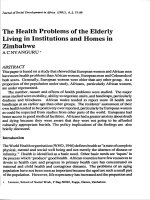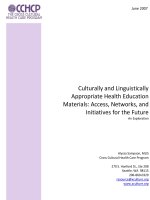Planning for the future –living trusts, estate and tax planning
Bạn đang xem bản rút gọn của tài liệu. Xem và tải ngay bản đầy đủ của tài liệu tại đây (222.16 KB, 66 trang )
Planning for the Future –
Living Trusts, Estate and
Tax Planning
By
Thomas F. McGuire
Robert I. Ury
Arnstein & Lehr LLP
© 2007 All Rights Reserved
Basic Estate Planning
Why do I need a Will?
Reasons:
• Control over who inherits (relatives,
charities, friends, etc.)
• Control over who administers estate
• Possible reduced costs
• Estate tax planning
• Structuring benefits for minor or
disabled beneficiary
• Designation of a guardian for minor
children
What is a “living trust”?
• You are the grantor/settlor
• You normally act as your own
trustee
• Provides for management of assets
at death or upon disability
• Substitutes for traditional will
Advantage of Living Trusts
• Avoidance of probate proceedings at
death
• Avoidance of guardianship
proceedings upon disability
• Ease of administration
• Reduced costs of administration
• Privacy and Timing Issues
Creditor Protection???
• Self-settled trust is not normally
protected from creditors
• Domestic protection trusts and
offshore trusts might offer some
protection
• Spendthrift provisions offer
protection to ultimate trust
beneficiaries
Marital Deduction
Planning
“Applicable Exemption Amount”
3,500,000
3,000,000
2,500,000
2,000,000
1,500,000
1,000,000
500,000
20042005
20062008
2009
2010
2011
0
Exemption
Combining Use of Unlimited
Marital Deduction and Exemption
Amount
• Unlimited marital deduction exists
for property passing to spouse
• Without proper planning, all property
will qualify for marital deduction and
exemption of first spouse will be
wasted
• Through proper planning, you can
double the amount of property
exempt from estate tax
Plan A: All to Spouse or
“I Love You” Plan
• At first death, all
property passes to
surviving spouse
• No tax is paid due
to marital
deduction
• At second death,
all property is
included in gross
estate
Results:
• Exemption of first spouse is wasted
• More estate tax is paid at second
spouse’s death
• Second spouse has total control over
assets – can give assets away to
whomever he or she chooses (i.e.
new spouse upon remarriage)
A Better Plan: Marital
Trust/Family Trust Arrangement
• Amount of
exemption
allocated to
Family Trust
• Amount in
excess of
exemption
allocated to
Marital Trust
Results:
• Property is available to surviving
spouse as needed, but Family Trust
is not taxed at survivor’s death
• Marital trust defers any estate tax
ultimately payable until after both
deaths
• Exemption is doubled
• If desired, deceased spouse retains
ultimate control over distribution
Trust Structure Issues
Long-Term Trusts
Generation-Skipping Trusts
• Makes property available to next
generation but keeps property out of
estate tax base
• Protects beneficiary’s interest from
claims of creditors
• Beneficiary can be trustee and can
have power of appointment
• Limitation – GST Exemption Amount
• “Dynasty” trusts and the Rule Against
Perpetuities
Criteria for Trust Distributions
•
•
•
•
•
Support
Comfort
Health
Education
Best Interests
• Standard of
living
considered?
• Possible use of
incentive
provisions?
• Beneficiary as
own trustee?
Powers of Appointment
• Build flexibility into estate plan
• Can be limited (i.e. descendants, spouses
& charities) or broad (anyone other than
creditors or estate)
• Can be lifetime or testamentary in nature
• Independent trustee can be given power to
create a power in the future – “power to
create a power”
Living Wills and Health Care
Powers of Attorney/Directives
• Allows doctor or
agent to make
health care
decisions
• Includes life
support
decisions
• Supplements
will or trust
Property Powers of Attorney
• Allows agent to manage financial
assets in the event of disability
• Should be made “durable” in nature –
effective even if legal
determination of disability
• Useful even if living trust is in place
Advanced Estate
Planning Techniques
Irrevocable Life Insurance
Trusts
• Allows removal of life insurance
from gross estate
• Trust is irrevocable in nature
• Removes “incidents of ownership”
from insured
• Caveat: Three Year Rule
• Also removes insurance proceeds
from second spouse’s estate
What is a “Crummey” notice?
• Allows gift to trust to qualify for
$12,000 per person annual exclusion
(avoids gift of “future interest”)
• Withdrawal right may be limited to a
window period
• Leverage of GST exemption possible
Qualified Personal Residence
Trust (“QPRT”)
• Gift of one or two residences to trust for a
term of years
• Gift is based upon actuarial remainder
interest at time of transfer
• Growth in value is removed from estate
• Upon expiration of term, grantor leases
property back from beneficiaries
• If residence sold, converts to a GRAT
arrangement
Grantor Retained Annuity
Trusts (“GRATs”)
• Individual transfers assets to a trust
for a fixed term reserving an annuity
interest
• Gift is valued based upon remainder
interest at time of transfer (“zero
out” GRAT possible)
• If trust can achieve rate of return
greater than IRS rate, tax savings
will be achieved
Family Limited
Partnerships/LLCs
• Discounting may be available for
estate and gift tax purposes –
Caveat: Strangi case
• Retention of control while shifting of
value
• Possible creditor protection
• Centralization of management
• Consolidation of assets









